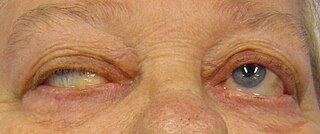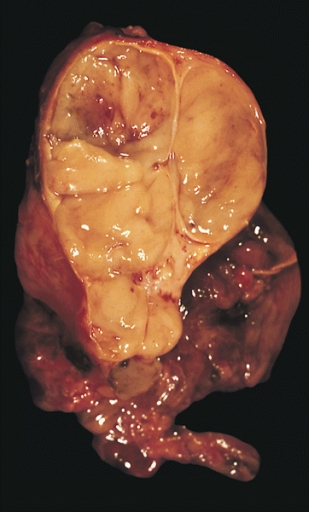Related Research Articles

Lambert–Eaton myasthenic syndrome (LEMS) is a rare autoimmune disorder characterized by muscle weakness of the limbs.

Myasthenia gravis (MG) is a long-term neuromuscular junction disease that leads to varying degrees of skeletal muscle weakness. The most commonly affected muscles are those of the eyes, face, and swallowing. It can result in double vision, drooping eyelids, and difficulties in talking and walking. Onset can be sudden. Those affected often have a large thymus or develop a thymoma.

Surgery is a medical specialty that uses manual and instrumental techniques to diagnose or treat pathological conditions, to alter bodily functions, to reconstruct or improve aesthetics and appearance, or to remove unwanted tissues or foreign bodies. The subject receiving the surgery is typically a person, but can also be a non-human animal.

The thymus is a specialized primary lymphoid organ of the immune system. Within the thymus, thymus cell lymphocytes or T cells mature. T cells are critical to the adaptive immune system, where the body adapts to specific foreign invaders. The thymus is located in the upper front part of the chest, in the anterior superior mediastinum, behind the sternum, and in front of the heart. It is made up of two lobes, each consisting of a central medulla and an outer cortex, surrounded by a capsule.
Cardiothoracic surgery is the field of medicine involved in surgical treatment of organs inside the thoracic cavity — generally treatment of conditions of the heart, lungs, and other pleural or mediastinal structures.

A thymoma is a tumor originating from the epithelial cells of the thymus that is considered a rare malignancy. Thymomas are frequently associated with neuromuscular disorders such as myasthenia gravis; thymoma is found in 20% of patients with myasthenia gravis. Once diagnosed, thymomas may be removed surgically. In the rare case of a malignant tumor, chemotherapy may be used.

A chalazion or meibomian cyst is a cyst in the eyelid usually due to a blocked meibomian gland, typically in the middle of the eyelid, red, and not painful. They tend to come on gradually over a few weeks.
Ocular myasthenia gravis (MG) is a disease of the neuromuscular junction resulting in hallmark variability in muscle weakness and fatigability. MG is an autoimmune disease where anomalous antibodies are produced against the naturally occurring acetylcholine receptors in voluntary muscles. MG may be limited to the muscles of the eye, leading to abrupt onset of weakness/fatigability of the eyelids or eye movement. MG may also involve other muscle groups.

A mediastinal tumor is a tumor in the mediastinum, the cavity that separates the lungs from the rest of the chest. It contains the heart, esophagus, trachea, thymus, and aorta. The most common mediastinal masses are neurogenic tumors, usually found in the posterior mediastinum, followed by thymoma (15–20%) located in the anterior mediastinum. Lung cancer typically spreads to the lymph nodes in the mediastinum.

Aphagia is the inability or refusal to swallow. The word is derived from the Ancient Greek prefix α, meaning "not" or "without," and the suffix φαγία, derived from the verb φαγεῖν, meaning "to eat." It is related to dysphagia which is difficulty swallowing, and odynophagia, painful swallowing. Aphagia may be temporary or long term, depending on the affected organ. It is an extreme, life-threatening case of dysphagia. Depending on the cause, untreated dysphagia may develop into aphagia.

Thymic carcinoma, or type C thymoma, is a malignancy of the thymus. It is a rare cancer that is often diagnosed at advanced stages. Recurrence following treatment is common, and thymic carcinoma is associated with a poor prognosis.
Thymus hyperplasia refers to an enlargement ("hyperplasia") of the thymus.
Thymoma with immunodeficiency is a rare disorder that occurs in adults in whom hypogammaglobulinemia, deficient cell-mediated immunity, and thymoma may develop almost simultaneously. Most reported cases are in Europe, though it occurs globally.

Philip Eugene Bernatz was an eminent American physician and thoracic surgeon at the Mayo Clinic, and an international authority on the diagnosis and treatment of thymoma and other tumors of the chest.
Ectopic thymus is a condition where thymus tissue is found in an abnormal location. It usually does not cause symptoms, but may leads to a mass in the neck that may compress the trachea and the esophagus. It is thought to be the result of either a failure of descent or a failure of involution of normal thymus tissue. It may be diagnosed with radiology, such as an ultrasound or magnetic resonance imaging. If it causes illness, surgery can be used to remove it. Recurrence after surgery is very unlikely.

Arvind Kumar is an Indian surgeon and the Chairman of Institute of Chest Surgery, Chest Onco Surgery and Lung Transplantation at Medanta Hospital, Gurugram and Founder & Managing Trustee, Lung Care Foundation. He is Former Chairman, Center for Chest Surgery and Director, Institute of Robotic Surgery at Sir Ganga Ram Hospital (SGRH) New Delhi. He is Former Professor of Surgery & Head of Thoracic & Robotic Surgery Unit, All India Institute of Medical Sciences (AIIMS), New Delhi (1988-2012). He was President of the Association of Surgeons of India in 2019.

A parotidectomy is the surgical excision (removal) of the parotid gland, the major and largest of the salivary glands. The procedure is most typically performed due to neoplasms (tumors), which are growths of rapidly and abnormally dividing cells. Neoplasms can be benign (non-cancerous) or malignant (cancerous). The majority of parotid gland tumors are benign, however 20% of parotid tumors are found to be malignant. Parotidectomy is performed mostly by oral and maxillofacial surgeon and ENT surgeon.
Hyperthermic intrathoracic chemotherapy (HITOC) is part of a surgical strategy employed in the treatment of various pleural malignancies. The pleura in this situation could be considered to include the surface linings of the chest wall, lungs, mediastinum, and diaphragm. HITOC is the chest counterpart of HIPEC. Traditionally used in the treatment of malignant mesothelioma, a primary malignancy of the pleura, this modality has recently been evaluated in the treatment of secondary pleural malignancies.
A cervical thymic cyst, also called thymopharyngeal duct cyst, is a fluid-filled mass that occurs when the thymopharyngeal duct, an embryonic structure connecting the nascent thymus with the embryonic pharynx, fails to close and disappear. A thymic cyst is typically a solitary mass on one side of the neck, and is usually found near the carotid sheath. Some cervical thymic cysts may extend into the mediastinum. It is usually asymptomatic. The diagnostic process includes differentiating between other causes of neck masses in infants and children, including branchial cleft cysts and cystic hygromas. The treatment is surgical excision. On histologic examination, the wall of the cyst includes thymic tissue, and may include parathyroid gland tissue because of the parathyroid gland's common embryonic origin with the thymus gland in the third pharyngeal pouch. Fewer than 100 cases of cervical thymic cysts have been reported in the medical literature.
References
- ↑ Calhoun RF, Ritter JH, Guthrie TJ, Pestronk A, Meyers BF, Patterson GA, et al. (October 1999). "Results of transcervical thymectomy for myasthenia gravis in 100 consecutive patients". Annals of Surgery. 230 (4): 555–9, discussion 559–61. doi:10.1097/00000658-199910000-00011. PMC 1420904 . PMID 10522725.
- ↑ Ng CS, Wan IY, Yim AP (June 2010). "Video-assisted thoracic surgery thymectomy: the better approach". The Annals of Thoracic Surgery. 89 (6): S2135-41. doi: 10.1016/j.athoracsur.2010.02.112 . PMID 20493997.
- ↑ "Thymectomy for Myasthenia Gravis". Cleveland Clinic. 14 May 2019. Retrieved 14 September 2020.
- ↑ "Thymectomy information". Myaware. 4 March 2020. Retrieved 14 September 2020.
- ↑ Plitas G, Rudensky AY (2020-03-09). "Regulatory T Cells in Cancer". Annual Review of Cancer Biology. 4 (1): 459–477. doi: 10.1146/annurev-cancerbio-030419-033428 .
- ↑ "Vaccination-Yellow fever". NHS. 23 October 2017. Retrieved 4 March 2021.
- ↑ Eidex, Rachel Barwick (2004-09-11). "History of thymoma and yellow fever vaccination". The Lancet. 364 (9438): 936. doi:10.1016/S0140-6736(04)17017-7. ISSN 0140-6736. PMID 15364184. S2CID 54408259.